
Downtown Bogotá as seen from the Colpatria Tower
In general, the cost of living in Colombia is very affordable for Americans. Like many countries, smaller cities or towns tend to be cheaper than larger, metropolitan cities. That being said, Bogotá is the largest city in Colombia with a population of 6.7 million people, and it’s still extremely cheap compared to the cost of living in the U.S. Here is a rough breakdown of what I spend each month on living expenses in Bogotá:
Groceries: $50 per month

$18,000 pesos ($6 USD) for all of this: 1 head of broccoli, a pack of mixed beans/vegetables, 5 bananas, 1 beet, 1 onion, a 4-pack of carambolas (starfruit), 1 yellow pitaya (dragonfruit), 1 pack of uchuvas (yellow gooseberries), a 6-pack of apples, a bag of green beans, and a bag of honey.
– 1 mango: $980 pesos / 35 cents
– 5 Chilean (imported) peaches: $5,000 pesos / $1.75
– 10 mini plums: $1,500 pesos / 55 cents
– 1 plantain: $1,800 pesos / 61 cents
– 6 apples: $4,300 pesos / $1.50
– 30 eggs: $7,800 pesos / $2.60
– A big carrot: $477 pesos / 16 cents
– A zucchini: $1,300 pesos / 44 cents
– A bag of green beans: $1,600 / 55 cents
– A bag of jelly: $2,500 pesos / 84 cents
– A bag of quinoa (300g): $4,500 pesos / $1.50
– A bag of lentils: $2,750 pesos / 92 cents
– Bottle of vinegar: $1,650 pesos / 55 cents
– A pack of 10 slices of mozzarella cheese: $6,050 pesos / $2.03
– Loaf of wheat bread: $3,250 pesos / $1.09
Eating out & Non-Grocery items (coffee, street food, etc.): $10-$50 per month
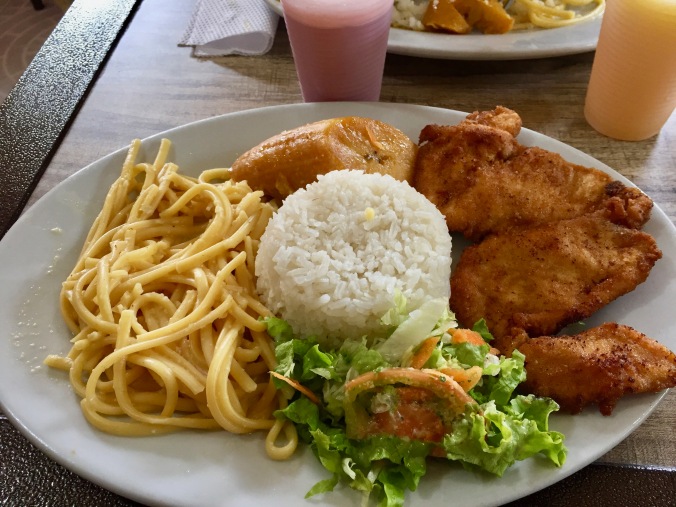
A typical lunch at a family restaurant: Ajiaco soup (not pictured), pasta, rice, a salad, chicken, a plantain, and mango juice. Cost: $7,000 pesos or $2.35 USD.
– A cup of tinto (black coffee): $2,000 – $4,000 pesos / 60 cents – $1.30
– 12 oz. latte at Oma (like Starbucks): $4,000 pesos / $1.35
– Large chocolate chip cookie at Oma: $2,100 pesos / 70 cents
– Arepas from the street: $2,000 – $6,000 pesos / 60 cents – $2
– Pack of gum: $2,000 – $3,000 pesos / 60 cents – $1
– Bottle of water: $2,000 pesos / 60 cents
– Small bag of nuts/raisins (maní): $2,000 pesos / 60 cents
– A typical lunch (at a family restaurant / cafeteria): $6,000 – $12,000 pesos / $2 – $4
A typical lunch (for example, at my university’s cafeteria) is $6,500 pesos ($2.20 USD) and includes meat, rice, another side (potatoes/lentils/plantains/pasta), a salad, a drink, and soup or a cup of fruit. You can easily find a similar lunch at basically any little restaurant on the street. These little restaurants sometimes have a lunch menu posted outside the restaurant with what they’re serving that day and the price. Furthermore, since the food is made in bulk that day, you’ll only have to wait a few minutes for it. Sometimes you’ll also get a choice (for example, of beef or chicken or mango juice or pineapple juice).
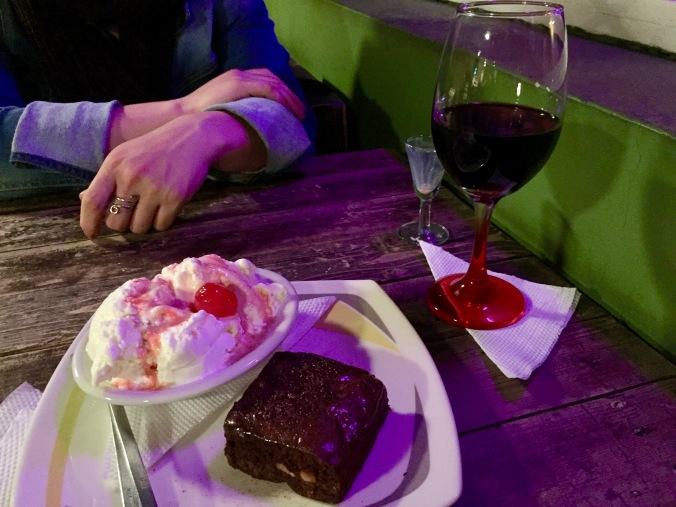
A brownie, ice cream, a shot of Bailey’s, and a glass of house wine at a bar/café in Teusaquillo for $18,000 pesos ($6 USD).
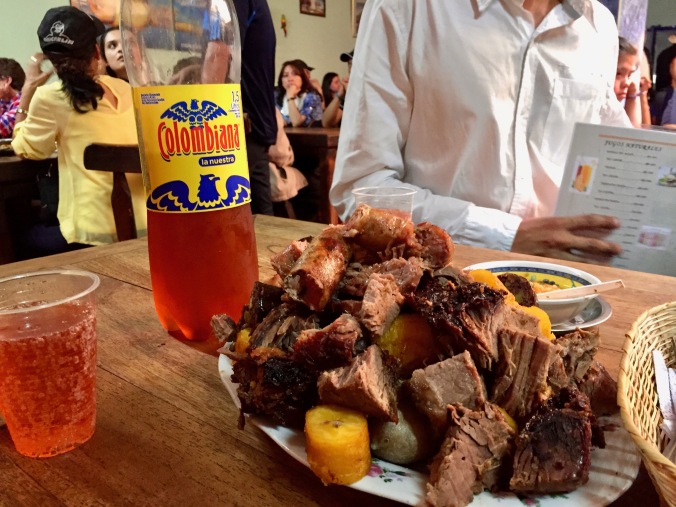
Picada (a big plate of assorted meats/sausages/potatoes/plantains) and Colombiana pop for about $12 USD (split between 3-4 people).
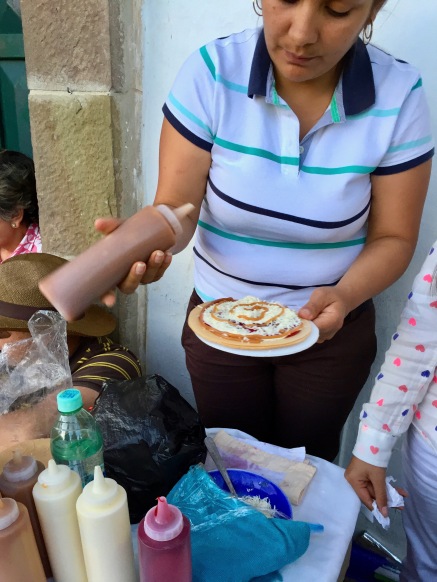
An oblea (2 wafers filled with arequipe, cream, strawberry sauce, chocolate sauce, and cheese) for $1 USD.
Other (toiletries, services, etc.): $0-$15 per month
– Loreal conditioner: $14,500 pesos / $4.85
– Large bottle of lotion: $10,900 pesos / $3.65
– 1 large roll of toilet paper: $1,000 pesos / 30 cents
– Large tube of Colgate toothpaste: $7,600 pesos / $2.60
– A bottle of contact solution: $38,000 pesos / $13.40
– A haircut: $9,000 pesos / $3
Transportation (Transmilenio, SITP bus, Taxis, Ubers): $10-30 per month (excluding transportation for traveling outside of the city)

Transmilenio in Bogotá. Picture courtesy of lightrailnow.org.
– 1 Ride on Transmilenio: $2,000 pesos / 68 cents
– 1 Ride on an SITP bus: $1,700 pesos / 58 cents
– Taxi/Uber ride: It depends on how far you go and at what time, but generally taxis and ubers are very affordable in Colombia. For example, a one-hour (!) Uber ride from my apartment to the airport in the early morning cost me 34,000 pesos or about $11.30.
Note that Ubers can often be cheaper than taxis, especially when the fewer ubers are in demand (meaning the price drops). While Uber is technically not legal in Colombia, it is often said that it’s safer than taxis. If you take a taxi in Bogotá, I recommend not taking one off of the street, but rather “ordering” one off of Easy Taxi or Tappsi, two taxi apps for smartphones. What I like about Uber is that it tells you the price beforehand, so the driver can’t charge you the famous “gringo tax” (when you get charged extra because you’re obviously a foreigner).
Rent (Small bedroom in an apartment shared with 3 Colombians): $350,000 pesos / $120 USD per month
Out of all the dozen or so Fulbrighters living in Bogotá, I am paying the least. Most other Fulbrighters who live closer to the downtown area (Chapinero/Teusaquillo) pay anywhere from $500,000 pesos to $1 million pesos ($170 – $330 USD) per month.
I currently share a two-floor apartment with one Colombian woman. It has two large bedrooms, two bathrooms, two little office spaces, a big living room with a fireplace, a kitchen, and a laundry/storage room. I didn’t get this room by searching online, however. The woman works at the university I work at, and she offered her guest bedroom to me at any cost. Since I was searching for something between $300,000 and $400,000, I offered her $350,000 and she said that sounded good. The location is great (on Carrera 9 and close to Calle 170, near the university), plus there is an open gym, pool, and squash court. I’d definitely be paying more if I hadn’t made this connection with the woman at the university, so I’m pretty lucky to be paying what I’m paying and living where I’m living!
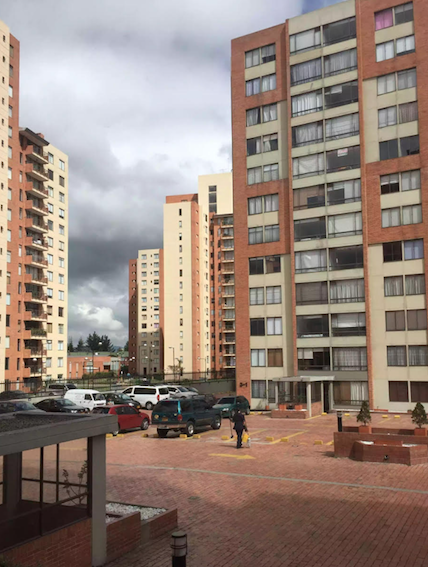
My new apartment complex on novena (carrera 9)
Before this, I was living near Portal Norte for $380,000 ($127 USD) and had three other roommates. I found the place on a Bogotá roommate page on Facebook. It was a small apartment, but it had three bedrooms (mine was the smallest), two bathrooms, a kitchen with a washing machine, and a living room area.
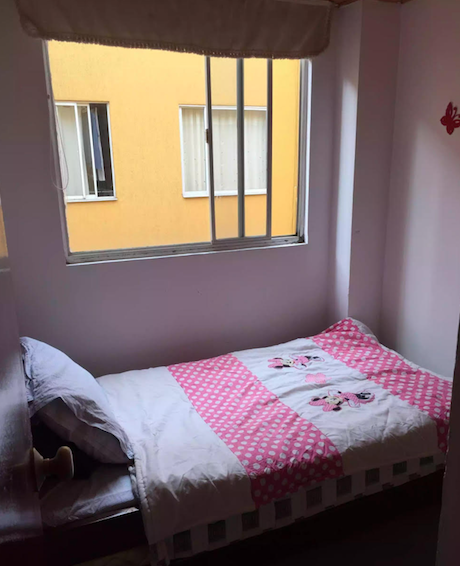
My bedroom at my apartment by Portal Norte (the sheets were not my choice…) 😉
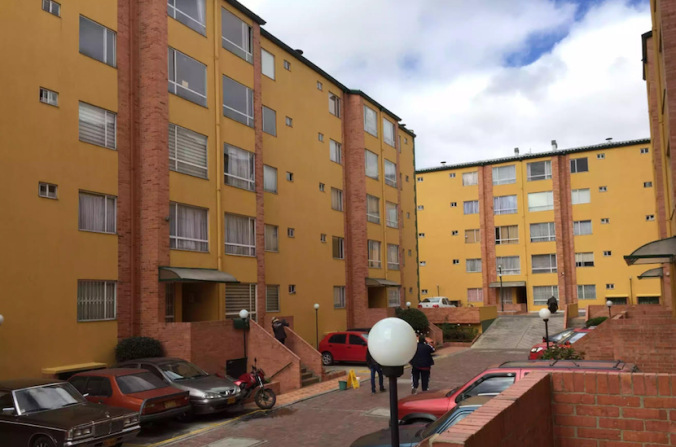
My apartment complex near Portal Norte
Phone service (through Tigo): $47,900 pesos / $16
My monthly plan with Tigo includes a certain amount of minutes and texts each month (which I rarely use), and unlimited WhatsApp, Facebook, and Twitter. Most Colombians use WhatsApp to communicate, so that’s the biggest advantage of this plan. From what I’ve seen, Claro and Movistar offer similar plans around the same price.
Entertainment (Movies, Events, Museums, etc.): $20-$50 per month
– Movie theater tickets (on discounted Wednesdays): $6,000 pesos / $2
– “Wednesday Combo” at the movie theater (popcorn, drink, hot dog, chocolate bar): $10,000 pesos / $3.50
– Museum entrance fees: $0 – $10,000 pesos / $0 – $3.50
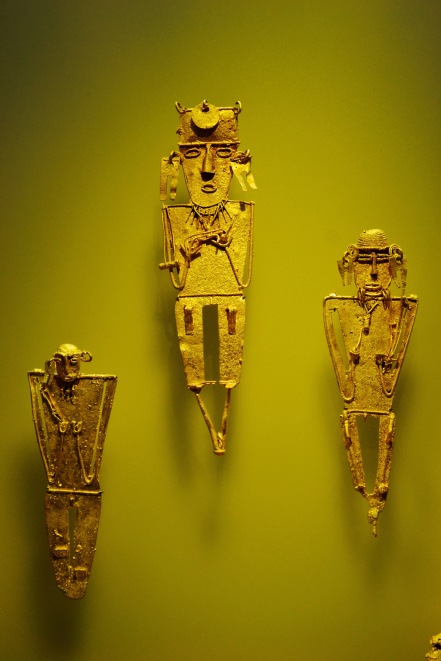
Museo de Oro (Gold Museum) in downtown Bogotá. Cost: $4,000 pesos ($1.34 USD) on Tuesday through Saturday and holidays, free on Sundays, and free for children under 12 and adults over 60.
Hospital/Doctor Bils: $0
I have gone to the hospital twice, once for stomach issues and once after getting hit by a motorcycle. For the stomach issues, I got a check-up and a prescription. When I went after getting hit by a motorcycle, I got a check-up, an x-ray, and a prescription. With Liberty Insurance (issued to us by the Fulbright program), I was charged $0 for these services. Hospitals and clinics might not have the best attention (for example: visiting two hospitals in one day and spending 8 hours in the clinics for simple stomach problems), but with free services, I can’t really complain!
Excluding travel outside of Bogotá (which is where most of my money goes), my total monthly expenses come out to:
~ $225 – $315 USD
Keep in mind that I’m not a big spender in general. I don’t buy many imported or organic foods from Carulla, for example. In fact, when I do go grocery shopping, I buy my veggies, fruits and potatoes from the small fruterías instead of chain stores likes Frutiver. I do, however, occasionally buy things in bulk like yogurt or rice from Jumbo or Éxito, two big chain grocery stores where I accumulate points. Sometimes the chain stores have some advantages. For example, I’ve heard that Carulla frequently has promotions for imported wines.
In general, living in Colombia is extremely affordable for Americans. Even though Bogotá is the largest city, it’s still easy to live cheaply. That means you can enjoy the country to its fullest…go out, eat well, travel, live in a nice apartment! Enjoy it all!